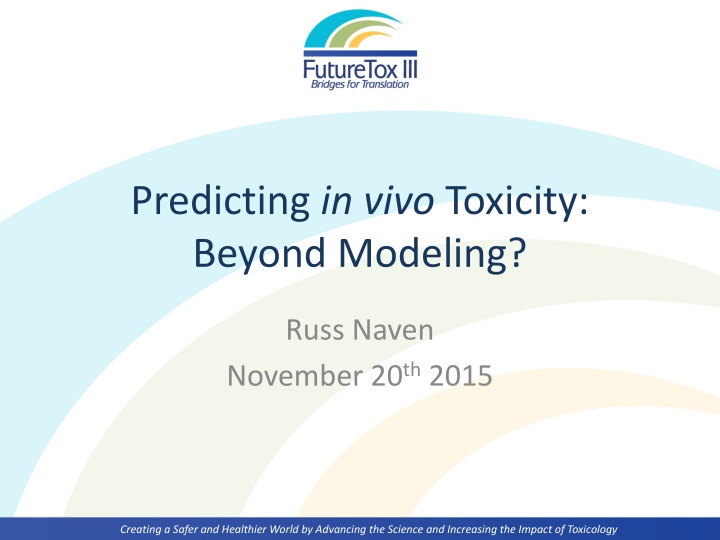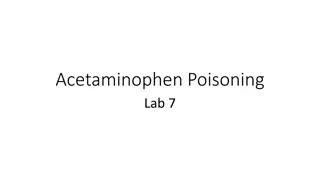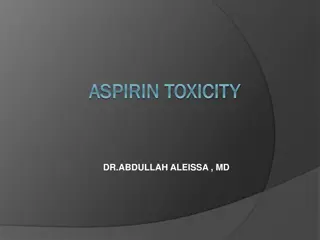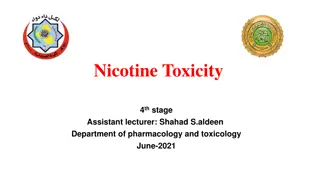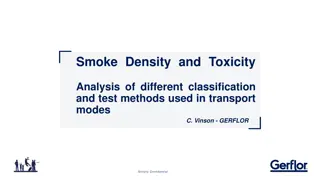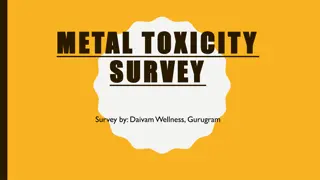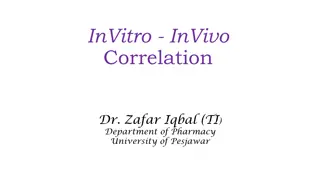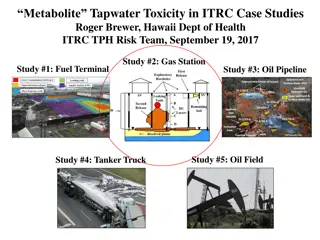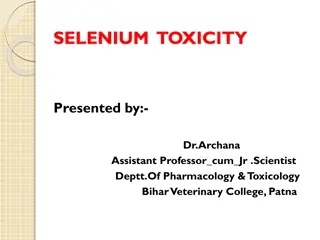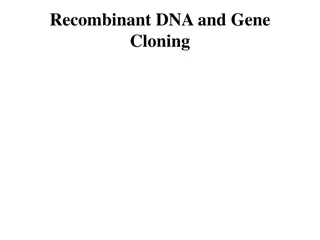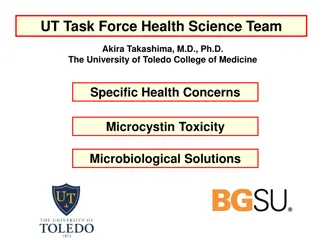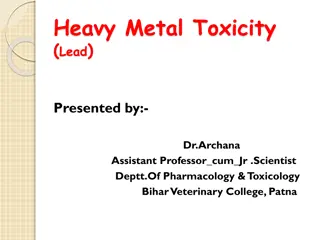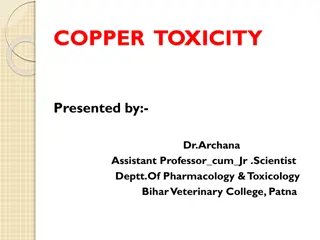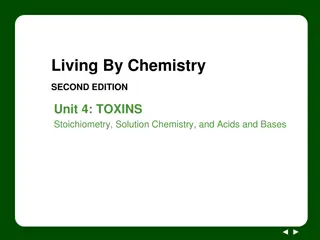Advancing In Vivo Toxicity Prediction Beyond Modeling
Explore the challenges and opportunities in predicting in vivo toxicity beyond traditional models. Learn about confidence in toxicity prediction, recently discontinued drugs due to safety concerns, and the importance of recognizing toxicological signals in preclinical stages. Discover how computational toxicology and predictive models are bridging knowledge gaps in investigative toxicology.
Download Presentation

Please find below an Image/Link to download the presentation.
The content on the website is provided AS IS for your information and personal use only. It may not be sold, licensed, or shared on other websites without obtaining consent from the author.If you encounter any issues during the download, it is possible that the publisher has removed the file from their server.
You are allowed to download the files provided on this website for personal or commercial use, subject to the condition that they are used lawfully. All files are the property of their respective owners.
The content on the website is provided AS IS for your information and personal use only. It may not be sold, licensed, or shared on other websites without obtaining consent from the author.
E N D
Presentation Transcript
Predicting in vivo Toxicity: Beyond Modeling? Russ Naven November 20th2015 Creating a Safer and Healthier World by Advancing the Science and Increasing the Impact of Toxicology
Confidence in Ability to Predict Toxicity Modeling repeat dose toxicity Aromatic amine mutagenicity model Non-genotoxic carcinogencity External validation Future Confidence Toxicology = chaos deterministic Retrain model Herg Time (14 years)
Recently Discontinued Drugs Withdrawn owing to liver safety signals in Phase III:
Why No Preclinical Attrition? Perhaps toxicological signals were not observed Maybe signals were observed but their significance was not recognized were considered manageable Toxicological knowledge gaps
Exposing Toxicological Knowledge Gaps Computational Toxicology Predictive in vitro/ in silico models in vivo toxicology data Investigative Toxicology
Exposing Toxicological Knowledge Gaps Model Applicability domain
Example Pfizer Study: What Features Are Predictive of in vivo Toxicity 207 preclinical candidates investigated Compounds were annotated against the observation of any in vivo toxicity findings at 10 M (total plasma exposure) Odds of toxicity established for various physicochemical properties TPSA and ClogP are calculated measures of lipophilicity Hughes et al, Bioorg&Med Chem Lett, 2008,18, 4872 4875
Thresholds Are Not Universally Applicable pKa Class Distribution within dataset Data from Hughes et al, Bioorg&Med Chem Lett, 2008,18, 4872 4875 Basic e.g. aminergenic cpds Training set is dominated by lipophilic basic drugs Lipophilic basic drugs cause general toxicity, e.g. through lysosomal dysfunction, disruption membrane integrity and inhibition of ion channels and adrenergic GPCRs
Thresholds Are Not Universally Applicable Neutral Training set is dominated by lipophilic basic drugs Lipophilic basic drugs cause general toxicity, e.g. through lysosomal dysfunction, disruption membrane integrity and inhibition of ion channels and adrenergic GPCRs
AZ Study: What Features Are Predictive of Preclinical Survival Different profile to Pfizer study: Toxicity Odds D. Muthas et al, Med. Chem. Commun., 2013, 4, 1058
Results from A Pan-Pharma Study Data from AZ, Eli Lilly, GSK and Pfizer Focus on preclinical survival Waring et al, Nature Reviews Drug Discovery 14, 475, 2015
Global Computational Analyses Are useful in that they identify broad physico- chemical features associated with toxicity Often related to exposure These properties applicable across all chemical space Unlikely to identify biological descriptors/mechanisms Only applicable to certain subclasses of compounds The utility of computational analyses is in the identification of toxicological knowledge gaps!
Understanding Liabilities in Acidic Compounds Hypothesis: in vivo toxicity of acidic compounds may be masked in in vitro assays owing to protein binding to assay serum Satoko Kakiuchi-Kiyota, The Toxicologist (SOT) 2015
Toxicity is Multifactorial: Nefazodone Potent 5-HT2A receptor antagonist and antidepressant Withdrawn 2003 for very rare, but severe, liver toxicity Has multiple safety liabilities Contains structural alert (aniline)1 Metabolic liabilities2 Inhibitor bile-salt export pump3 Cytotoxic4 Mitochondrial dysfunction4 High dose: >200mg/day Refs 1. Stepan et al., Chem. Res. Toxic., 2011, 24, 1345-1410. 2. Kalgutkar et al., Drug Metab. Disp., 2005, 33, 243-253 3. Kostrubsky et al, Toxicol. Sci., 2006, 90, 451-459 4. Dykens et al., Toxicol. Sci., 2008, 103, 335-345.
Toxicity is Multifactorial: Aripiprazole Structurally similar, yet successfully marketed drug No reports of acute hepatotoxicity Has multiple in vitro liabilities Contains structural alert (aniline) 1 Metabolic liabilities2 Cytotoxic and lysosomotropic3 Low dose: 10-20 mg/day Can we confidently class aripiprazole as non-hepatotoxic? Refs 1. Stepan et al., Chem. Res. Toxic., 2011, 24, 1345-1410. 2. Bauman et al., Drug Metab. Disp., 2008, 36, 1016-1029. 3. Nadanaciva et al., Toxicol. in Vitro, 2011, 25, 715-723.
Toxicological Data is Very Noisy .like this NMR spectra?! Wiki: Loteralle Wiki: T.vanschaik
Tox21 Data Heat map of 110 pharmaceutical compounds tested against 801 assays Shah and Greene, Chem Res &Tox, 2014, 27, 86-98
Analogues Can Drive Hypothesis Generation Why different toxicity profile? ADME? Target Potency? Off-target pharmacology? (GSID_47281) (GSID_47278) CAR, RXRb, RORg Shah and Greene, Chem Res &Tox, 2014, 27, 86-98
Analogues Can Drive Hypothesis Generation Why different toxicity profile? ADME? Target Potency? Off-target pharmacology? (GSID_47281) TX006173 (GSID_47282) (GSID_47278) PDE10, PPARa CAR, RXRb, RORg Shah and Greene, Chem Res &Tox, 2014, 27, 86-98
Different Chemotypes for the Same Target Have Different Profiles
Developing Early Screening Paradigms Cell health and disruption of homeostasis Cytotoxicity Mitochondrial Dysfunction ROS/NOX induction Promiscuity measure Targets/phenotypic assays linked to toxicity ion channels, hERG (cardiotox) GPCRs (5HT2b agonism) Specific cellular assays (iPS cells) Cytokine storm Disruption of Cellular Differentiation? 22
Recent Marketed Example Tolvaptan Competitive vasopressin receptor 2 antagonist by Otsuka Pharm Approved by the FDA 2009 2012: FDA Limits Duration and Usage Due To Possible Liver Injury Leading to Organ Transplant or Death Dose = 60mg/day Cmax 1 M (total) 23
Tolvaptan Has HepG2 Cytotoxic Liabilities Viability in Hepg2 cells: Why would a vasopressin receptor 2 antagonist cause cytotoxicity? 52.2 uM 33.0 uM Likely due to inherent properties of the compound? ROS Comet assay DNA oxidation Impact can be seen in other screening assays: Wu et al. Biochemical Pharmacology 95 (2015) 324 336 24
Tolvaptan May Disrupt Bile Acid Transport Slizgi et al. Tox Sci Advance Access published October 26, 2015 25
Summary Toxicology is exceptionally complex Recognize limitations of global computational analyses Improving toxicity prediction means deeper understanding of our tox data Understand the applicability of assays and models Identify knowledge gaps and drive investigative towards addressing them Chemical/computational toxicology is inseparable from investigative toxicology 26
Acknowledgements Yvonne Dragan Nigel Greene Jodi Maglich Goodwin Shirley Louise-May Satoko Kiyota Thank you for listening!
